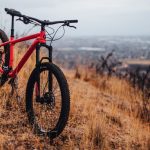Mountain biking has exploded in popularity over the past few decades. Riding off-road through rough terrain and over obstacles presents a fun challenge. But having the right bike matters tremendously for control and overall experience. So what separates good mountain bikes from ones that underperform? Many factors from frame design to component quality play a role.
Strong, Lightweight Frames
At its core, a quality mountain bike starts with a strong yet lightweight frame. The frame construction and material determines ride characteristics like responsiveness, durability, and weight distribution. Ideal mountain frames resist impact forces without feeling overly harsh or flexy.
Steel frames offer reliable strength at an affordable price point. Hardened steel tubing can take a beating season after season with minimal risk of cracks or failures. The downside is steel weighs more than other options like aluminum and carbon fiber. This added heft makes bikes feel less agile on climbs.
Aluminum alloys strike a nice balance of light weight, durability and compliance for most riders. Butting techniques allow thick aluminum where needed for reinforcement. But aluminum frames can feel harsh on rough trails. Advanced metallurgy creates plusher ride qualities but costs rise accordingly.
For elite cross-country and downhill racing models, carbon fiber frames emerge as the premium choice. Carbon composites achieve best-in-class low weights around two pounds or less. They also provide vibration damping and tuned flex without sacrificing stiffness. However, carbon carries a premium price tag and remains less impact-resistant.
No matter the frame material, good mountain bikes utilize advanced design features. Compact geometry with slack head tube angles helps with downhill stability. Oversized tubing increases frontal rigidity and steering precision as well. Smoothly curved and hydroformed frame shaping improves strength-to-weight ratios.
High-Performance Suspension
Any quality modern mountain bike needs some form of suspension to smooth out trail chatter and big hits. Suspension preserves traction and control while offering a more comfortable ride. Both the front fork and rear shock require proper setup for optimal performance.
Air spring suspension dominates the high-end market. These systems use compressed air canisters rather than coiled metal springs. Air allows infinite fine-tuning of ramp-up progressiveness and bottomless feel. Adjustable rebound and damping circuits further optimize suspension response.
High quality coil spring forks and shocks remain the most affordable suspension option. Carefully matched coils strike a balance between small bump compliance and bottom-out resistance when built right. Multiple rubber elastomers and oil damping tune the compression and rebound characteristics.
For frame-mounted rear suspension, leading brands favor compact metric shocks over larger piggyback designs. Metric sizing reduces weight and complexity while offering similar tuning abilities at a lower center of gravity. Four-way adjustable damping remains the gold standard.
With forks, chassis rigidity is just as crucial. High-end models use shaped one-piece aluminum or carbon fiber lowers offering unrivaled stiffness and steering precision. Increased bushing overlap also reduces binding and flexing compared to two-piece lowers.
Powerful Braking Systems
Quality brakes provide the power and modulation to scrub speed safely when needed during descents. Having the proper braking hardware increases rider confidence on steep or technical trails.
Top mountain bike brakes utilize hydraulic disc calipers and rotors rather than rim-style brakes. Disc systems feature larger surface areas and progressive power delivery with no fading or noise. Better heat management also ensures consistent lever feel even during extended braking.
For performance models, top brands specify four-piston calipers rather than two-piston designs. The added pistons create clamping forces easily capable of locking wheels for abrupt stops. Integrated heat sink fins further boost cooling efficiency. Metallic compound brake pads provide long life and bite with improved modulation as well.
Rotor size also matters for quality braking. Most mountain bikes specify at least 180mm rotors in front to maximize leverage and leverage ratios. Larger 200-220mm rotors enable smoother modulation and more power for downhill or enduro applications.
Finally, top brakes utilize stainless steel banjo bolts and reinforced brake lines. Minor upgrades like these banish air pockets and fluid expansion for a consistent firm lever feel. Having zero sponginess or wander dramatically improves trail confidence.
High-Traction Tires
When it comes to tackling off-road terrain and obstacles, tire choice heavily impacts a mountain bike’s overall capability. Ideal knobbies maximize traction while resisting punctures and trail damage. Both tread patterns and rubber composites play an important role.
For all-around trail use, many riders opt for knobby all-terrain tires with alternating center rows and gripping side lugs. These tread patterns balance low rolling resistance for pedaling yet still hook up in corners and over slick rocks. Some versions include siping or micro-sipe cuts to further boost bite in mud and softer conditions.
The most aggressive tires incorporate knob and block treads meant to dig hard into loose terrain like rock gardens. Widely-spaced staggered lugs ensure consistent edge grip and debris release. These tires thrive in dry uphill and downhill scenarios but sacrifice efficiency on smoother trails.
While thread patterns grab the ground, rubber tire compounds determine grip intensity. Tackier rubber found on high-end treads conforms better to irregular surfaces like roots and ruts. However, softer compounds wear quicker and create more rolling resistance. Firmer compositions provide durability but harsher impacts.
Tubeless setups also provide major advantages over mountain bike tubes. Tubeless rims allow lower tire pressure for improved cornering and traction without sacrificing stability or risking pinch flats. Sealant plugs small punctures while self-sealing foam inserts enable temporary tube-free riding too.
Strong, Stiff Wheels
Of course, tires mean nothing without proper wheels at their foundation. A quality wheelset transfers power and absorbs impacts efficiently while also accelerating quickly. Wheel construction and componentry determine overall stiffness and reliability across rough terrain.
Wider rim profiles create a more stable and forgiving footprint for lower tire pressures. Wider rims drastically improve traction and handling compared to old school narrow designs still lingering on cheaper bikes. Modern mountain bike rims range from 25mm to 40mm inner widths.
For the spokes, triple butted versions strike the best balance of strength, weight and compliance. Compared to heavier straight-gauge options, triple butted spokes are lighter with minimal compromises for high-stress riding. They offer just enough flex to absorb impacts without feeling noodly. Pre-tensioning creates a stiffer, more durable spoke bed too.
Best-in-class mountain bike wheels also feature machined billet hubs for maximum durability. These hoops eliminate any flex or wobble that can plaque cast splined hub designs. Lightweight oversize hub axles with sealed cartridge bearings also add longevity and smoothness.
Many performance mountain bikes ship with sturdy alloy wheels built for reasonable weights under twelve pounds. But for enthusiasts seeking the pinnacle of lateral stiffness and minimal rotating mass, carbon fiber laminates rule supreme. Optimized carbon layups achieve incredible lateral wheel stiffness with weights under ten pounds.
Crisp, Reliable Shifting
Just as important as strong wheels is having a reliable drivetrain and shifting system. Poor shifting translates to lost traction, chain drops, and wasted pedal energy. Proper gear actuation becomes especially crucial on rocky, technical climbs. Crisp precise shifts keep rides enjoyable.
Most quality mountain bikes use clutch rear derailleurs featuring a one-way roller bearing clutch mechanism. These capture chains over chainstays to minimize slap and dropped chains. The clutch acts like a suspension damper when impacting rocks and roots.
For gearing ranges, bikes emphasizing pedaling performance skew towards close-ratio cassettes with smaller spread between cogs. Having frequently spaced gears in the 10-42t range allows maintaining ideal cadence through varying terrain. Closer gearing eliminates pedal timing disruptions so riders conserve energy.
Meanwhile bikes focused on downhill gravity roles utilize wide-range cassettes with massive 10-52t spreads. The huge spacing accommodates pedal sections but maintains crawler gear climbing ability. Matched cranksets feature small chainring sizes like 24-32t for ideal chain angles and ground clearance.
Intelligent Bike Integration
High-quality modern mountain bike designs marry all the separate componentry together into integrated cohesive systems. This synergistic integration optimizes how each part interacts with the frame and other pieces. The harmonious part matching creates bikes that outperform the sum of their individual parts.
Smart frame designs provide proper tire clearance and protective rubber guards to minimize impacts. Cable routing enables smooth brake line and shifter housing paths with minimal exposed segments. Tucked areas or tubes also guide dropper post travel safely.
Suspension kinematics like anti-squat ratios get precisely tuned through pivot and linkage locations. This virtual gearing balances pedaling efficiency with square movement under impact. On-the-fly compression adjustment dials independently tune front and rear end feel.
Even dimensions and Q-factors follow consistent lineups across bike categories with minor adjustments. This uniformity maintains proper rider positioning and pedal stroke. Consistent cockpit layouts and bar/stem interfaces also carry over across product tiers.
For more information on what components make a great mountain bike and expert advice, be sure to check out articles from top cyclists and gear blogs covering the topic. With proper knowledge, you can optimize your dream bike setup.
Making the Final Judgments
With so many mountain bike models across different categories, it’s hard to definitively say one bike or component reigns supreme across every metric. What constitutes a “good” bike always involves compromises to suit varied riding styles and budgets.
For example, elite racers may prioritize the lightest frame and components possible even at the expense of vibration harshness. More casual trail riders may instead value moderately-weighted durability and compliance over marginal gains on the scale.
Even within component areas like wheel sets, the “best” depends on priorities. Stiffer carbon laminates may corner and transfer power better for quick bursts. But aluminum hoops provide cheaper longevity suited for mellower overall rides. Both possess merits.
Still, certain product features absolutely elevate bikes over the competition. Higher quality suspension damping, disc brake power/modulation, tubeless tires and thoughtful frame designs enhance overall experience immensely. So savvy component selection resonates over cutting costs.
That’s why top trail and all-mountain bikes from established brands garner such praise from enthusiasts. Their attention to detail and synergistic integration results in confidence-inspiring rides over the roughest terrain. Suspension behaves intuitively while drivetrains and brakes perform flawlessly.
At the end of the day, the “best” mountain bike incorporates high-end components built purposefully for your specific riding objectives. Making informed choices on componentry achieves a customized bike that meets your personalized measures of ideal performance and enjoyment. With some knowledge, you can construct the optimal machine to tackle any trail.






